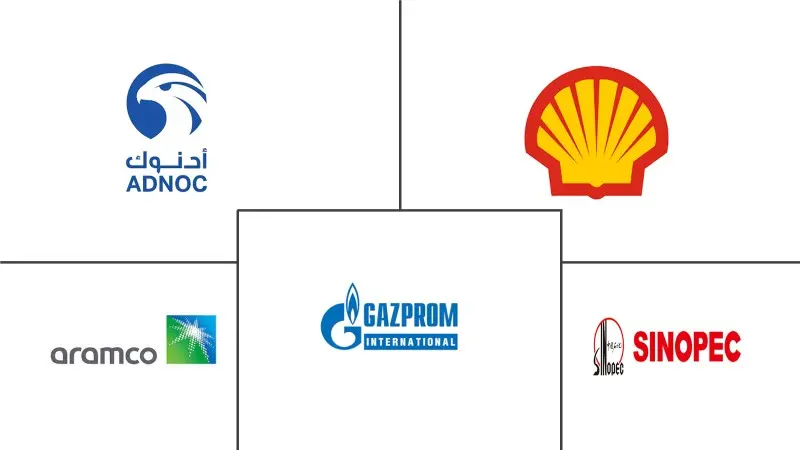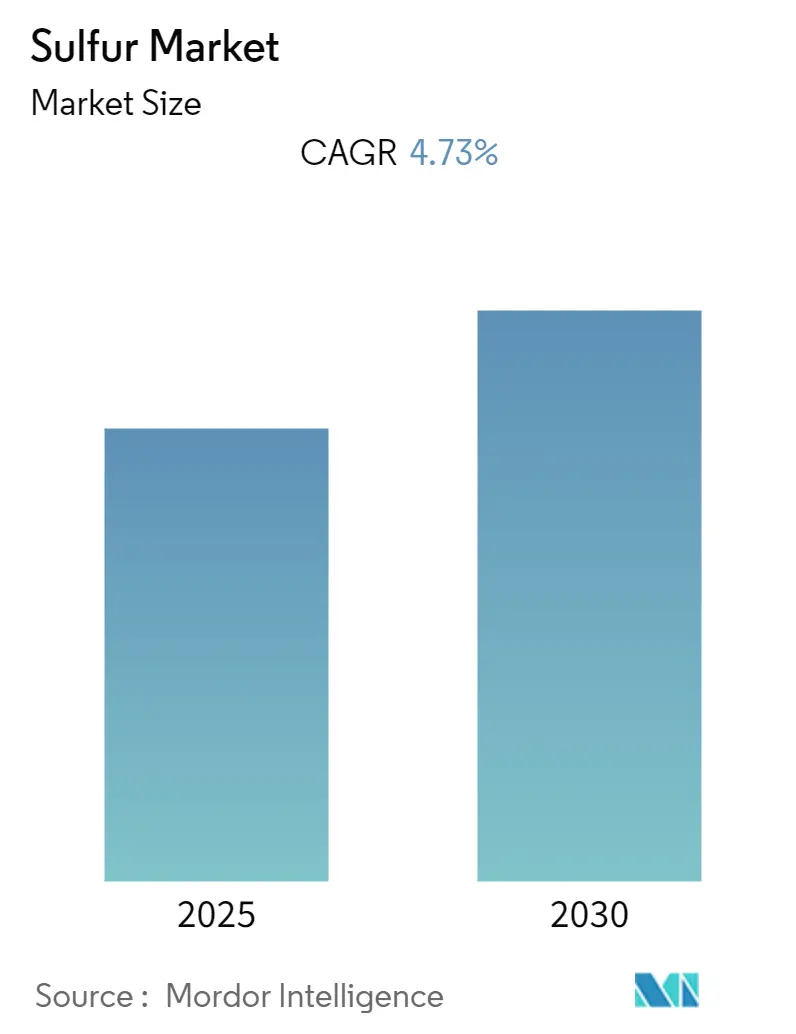
Sulfur Market Analysis
The Sulfur Market is expected to register a CAGR of 4.73% during the forecast period.
The global sulfur industry is experiencing significant transformation driven by evolving industrial dynamics and technological advancements. The chemical processing sector, a major consumer of sulfur, has shown remarkable resilience with production facilities expanding across key regions. According to the U.S. Geological Survey, global sulfur production reached a significant milestone in 2022, with the United States alone producing 8.6 million metric tons, representing a 6.6% increase from the previous year. Major chemical manufacturers are investing in capacity expansions, with companies like BASF announcing a USD 780 million investment in 2023 to double production capacity at its Louisiana chemical manufacturing complex, signifying growing industrial demand for sulfur-based products.
The steel manufacturing sector is undergoing a substantial shift toward more environmentally sustainable practices, particularly in developed regions. This transition is characterized by the increasing adoption of electric arc furnace (EAF) technology, which requires specific grades of sulfur for processing. Saudi Arabia's steel sector demonstrated this trend with crude steel production reaching 9.1 million metric tons in 2022, while implementing advanced technologies for reduced emissions. The industry's focus on green steel production has led to increased investments in sulfur-based technologies for emissions control and quality enhancement.
Infrastructure development and construction activities are creating new avenues for sulfur utilization, particularly in emerging economies. China's sulfuric acid production reached 95.05 million metric tons in 2022, marking a 1.3% increase from the previous year, largely driven by industrial expansion and construction activities. The development of sulfur-enhanced construction materials, including specialized concrete and asphalt formulations, is gaining traction across major infrastructure projects, particularly in regions focusing on durability and chemical resistance.
The industry is witnessing a significant shift in trade dynamics and supply chain configurations. According to the International Fertilizer Association, global fertilizer consumption is expected to recover by 3% in FY 2023, reaching 194 million tons of nutrients, indicating a robust demand for sulfur in agricultural applications. Major sulfur producers are establishing strategic partnerships and investing in logistics infrastructure to ensure stable supply chains. This is evidenced by recent developments in the Middle East, where significant investments are being made in sulfur handling and processing facilities to meet growing global demand while maintaining environmental compliance.
Sulfur Market Trends
Rising Demand from the Fertilizer Manufacturing Sector
The fertilizer manufacturing sector continues to be a primary driver for the sulfur market, as sulfur serves as a critical raw material in fertilizer production. Sulfur fertilizers, both organic and synthetic, play a vital role in boosting agricultural productivity by delivering essential nutrients to plants and improving soil fertility. The significance of sulfur in agriculture has elevated it to the status of a fourth macronutrient alongside phosphorus, nitrogen, and potassium, particularly due to its crucial role in protein synthesis and chlorophyll formation in plants. Additionally, sulfur-based fertilizers have proven effective in preventing nutrient runoff and soil erosion, while also serving as a natural pesticide against insects, fungi, mites, and rodents.
The fertilizer industry is witnessing significant expansion through strategic investments and government initiatives. For instance, in September 2022, Nouryon's acquisition of ADOB Fertilizers demonstrated the industry's focus on global growth and market expansion. In a notable development from February 2023, the Indonesian Fertilizer Producers Association announced the launch of the Pusri 3B fertilizer factory project, which aims to achieve a production capacity of 16.87 million tons upon completion by 2030, representing a substantial increase from the current 13.97 million tons. These developments, coupled with the Middle East's ambitious target to achieve fertilizer production of 50 million tons by 2035, indicate strong growth prospects for sulfur demand in fertilizer manufacturing.
Increasing Usage of Sulfur for Vulcanization of Rubber
The vulcanization of rubber represents a significant driver for sulfur demand, as the process requires sulfur to create cross-links between polymer chains, enhancing rubber's mechanical properties including tensile strength, elasticity, and durability. The rubber processing industry's expansion is particularly evident in Asia-Pacific, where numerous manufacturing facilities are driving substantial demand for sulfur. India alone hosts approximately 6,000 rubber manufacturing units, comprising 30 large-scale facilities, 300 medium-scale operations, and 5,600 small-scale units, collectively producing over 35,000 different rubber products and creating significant demand for sulfur in the vulcanization process.
The rubber industry's growth is further supported by the strategic positioning of major rubber-producing countries and their expanding manufacturing capabilities. Thailand, Indonesia, and Malaysia collectively account for about one-third of global rubber consumption, with Thailand maintaining its position as one of the largest producers and exporters of natural rubber globally. The industry's robust growth is driven by increasing demand from various end-use sectors, particularly the automotive and industrial manufacturing segments, which require high-quality vulcanized rubber products with superior mechanical properties and durability. This increasing demand also influences the sulfur prices in the market, as manufacturers seek cost-effective solutions.
Expansion of Petroleum Refining Plants
The ongoing expansion of petroleum refining plants worldwide continues to drive the sulfur market, as sulfur is predominantly produced as a by-product of petroleum refining and natural gas processing. The refining industry's growth is particularly noteworthy in Asia-Pacific, where increased capacity and modernization efforts are leading to higher sulfur production. This is evidenced by China's record sulfuric acid production, which reached 95.05 million metric tons in 2022, marking the third consecutive year of growth with a 1.3% increase from the previous year's output.
The petroleum refining sector's expansion is characterized by significant investments in new facilities and the modernization of existing plants to meet environmental regulations and increasing demand for refined products. These developments are accompanied by the implementation of advanced sulfur recovery units and environmental control systems, which not only ensure compliance with stringent environmental regulations but also optimize sulfur recovery from refining processes. The industry's commitment to environmental sustainability and operational efficiency continues to drive innovations in sulfur recovery technologies, contributing to increased sulfur availability for various industrial applications. As a result, the sulfur price trends are closely monitored by industry stakeholders to anticipate market shifts and pricing strategies.
Segment Analysis: Form
Solid Segment in Global Sulfur Market
The solid sulfur market dominates the global sulfur market, accounting for approximately 81% of the total market volume in 2024. This significant market share is attributed to the segment's widespread commercial availability and ease of handling compared to liquid sulfur. The solid form's versatility in applications across fertilizer manufacturing, chemical processing, and metal manufacturing industries has reinforced its market dominance. Additionally, the segment benefits from advanced solidification technologies like granulation, pastillation, and prilling that enable manufacturers to produce high-quality solid sulfur products meeting diverse industry requirements. The segment is also experiencing the fastest growth trajectory, projected to expand at around 5% annually from 2024 to 2029, driven by increasing demand from the fertilizer sector and growing applications in rubber vulcanization. The solid segment's growth is further supported by ongoing investments in sulfur recovery and processing facilities globally, particularly in major producing regions like Asia-Pacific and North America.
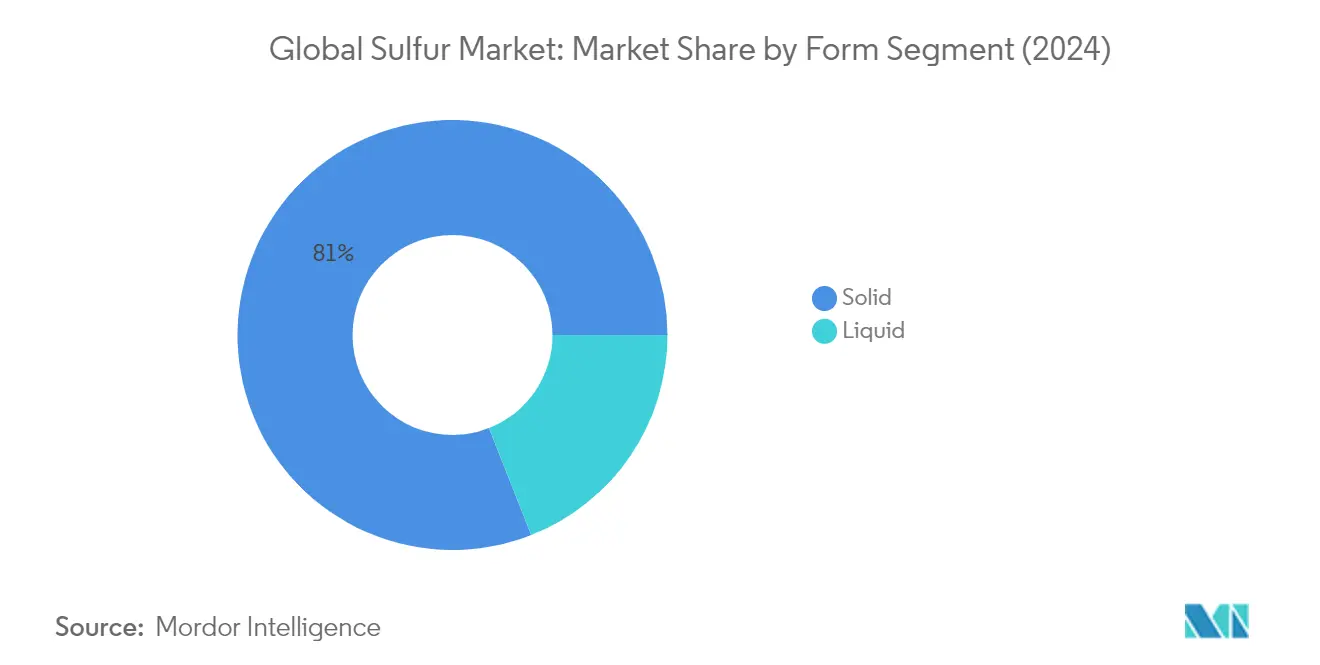
Liquid Segment in Global Sulfur Market
The liquid segment represents the remaining portion of the global sulfur market, serving specific industrial applications where molten sulfur is preferred. This segment's market position is supported by its essential role in certain chemical manufacturing processes and its use as an intermediate form in sulfur transportation and storage. The liquid form offers advantages in terms of bulk handling and processing efficiency for certain applications, though its market share is constrained by the additional infrastructure requirements for handling and maintaining sulfur in its molten state. The segment maintains steady growth driven by demand from specialized industrial applications and the expansion of sulfur processing facilities worldwide.
Segment Analysis: Technology
Granules Segment in Global Sulfur Market
The granular sulfur market dominates the global sulfur market, accounting for approximately 75% of the total market share in 2024. This significant market position is attributed to the segment's high production capacity, with single-unit granulators capable of producing up to 720 tons per day, surpassing other solidification technologies. The granulation process involves spraying liquid sulfur inside a rotating drum where sulfur seeds are formed and gradually built up to reach 2-6 mm size. This method's popularity stems from its efficiency in achieving high production volumes and the resulting granules' suitability for various applications, particularly in the agricultural sector where they provide essential plant nutrition. The segment is also experiencing the fastest growth rate in the market, driven by increasing demand from fertilizer manufacturers and the method's cost-effectiveness compared to other solidification technologies. However, the process does face some challenges, including the risk of sulfur dust formation during processing and potential fire hazards, which manufacturers address through stringent safety protocols and advanced production technologies.
Pastilles Segment in Global Sulfur Market
The pastilles segment represents a significant portion of the sulfur market, characterized by its environmentally friendly production process and superior quality output. This segment has gained considerable traction due to its unique production method where drops of liquid sulfur are placed on a steel belt cooler in regular rows, forming uniform and hemispherical pastilles. The process offers several advantages, including minimal environmental impact since sulfur doesn't come in direct contact with water, eliminating cross-contamination risks. The pastillation method also stands out for its dust-free operation, uniform shape production, and excellent product stability. The segment's growth is further supported by the fast cooling process on the steel belt, which minimizes vapor release and oxygen contact with the hot product, resulting in higher quality output. Additionally, the method's efficiency in water circulation, minimal spare part requirements, and easy scalability through integration with additional units make it increasingly attractive to manufacturers looking for sustainable production methods.
Remaining Segments in Technology Segmentation
The prilling segment, while smaller in market share, plays a crucial role in the sulfur market by offering unique advantages in specific applications. Prilling technology produces perfectly spherical pellets with polished surfaces that are easier to handle and exhibit better flow characteristics compared to granulated forms. This process involves pumping molten sulfur through perforations to produce narrow sulfur streams that fall into an agitated water bath, resulting in uniform-sized, low-moisture prills. The segment's significance lies in its ability to produce high-purity sulfur prills that can easily dissolve in water, making them particularly valuable for applications requiring precise quantities, such as agriculture. The process requires no additives, ensuring 100% purity, and the resulting prills demonstrate excellent resistance to abrasion and damage, while maintaining minimal dust formation properties.
Segment Analysis: End-User Industry
Fertilizer Segment in Sulfur Market
The fertilizer segment continues to dominate the global sulfur market, holding approximately 89% market share in 2024. This substantial market share is primarily driven by the extensive use of sulfur in the production of sulfuric acid, which is a crucial component in manufacturing phosphate fertilizers and other agricultural nutrients. The segment's dominance is further reinforced by the growing global focus on food security and agricultural productivity, particularly in emerging economies. Major fertilizer manufacturers are expanding their production capacities through geographical expansion, acquisitions, mergers, and collaborations to meet the rising demand. The increasing adoption of precision farming techniques and the need for enhanced crop yields have also contributed significantly to the segment's market leadership.
Chemical Processing Segment in Sulfur Market
The chemical processing segment is projected to exhibit the highest growth rate of approximately 6% during the forecast period 2024-2029. This accelerated growth is attributed to the expanding chemical industry globally and increasing investments in chemical manufacturing facilities. The segment's growth is particularly driven by the rising demand for sulfuric acid in various industrial applications, including metal processing, wastewater treatment, and petroleum refining. The chemical processing segment is witnessing significant technological advancements and capacity expansions, especially in Asia-Pacific and North America. The increasing focus on sustainable chemical processing methods and the development of new applications for sulfur-based chemicals are further propelling the segment's growth trajectory.
Remaining Segments in End-User Industry
The metal manufacturing, rubber processing, and other end-user industries constitute the remaining segments of the sulfur market, each playing crucial roles in different industrial applications. The metal manufacturing segment utilizes sulfur primarily in steel production and metal treatment processes, while the rubber processing segment employs sulfur extensively in vulcanization processes for tire manufacturing and other rubber products. Other end-user industries include pharmaceuticals, textiles, and construction materials, where sulfur finds applications in various forms. These segments are influenced by factors such as industrial growth, technological advancements, and environmental regulations governing sulfur usage in different applications.
Sulfur Market Geography Segment Analysis
Sulfur Market in Asia-Pacific
The Asia-Pacific region represents the dominant force in the global sulfur market, driven by extensive industrial development and growing agricultural activities across multiple countries. China leads the regional sulfur market with its massive chemical and fertilizer manufacturing base, followed by India's expanding industrial sector. Japan and South Korea contribute significantly through their advanced chemical processing and metal manufacturing industries, while ASEAN countries demonstrate increasing demand from various end-use sectors, including fertilizer production and rubber processing.
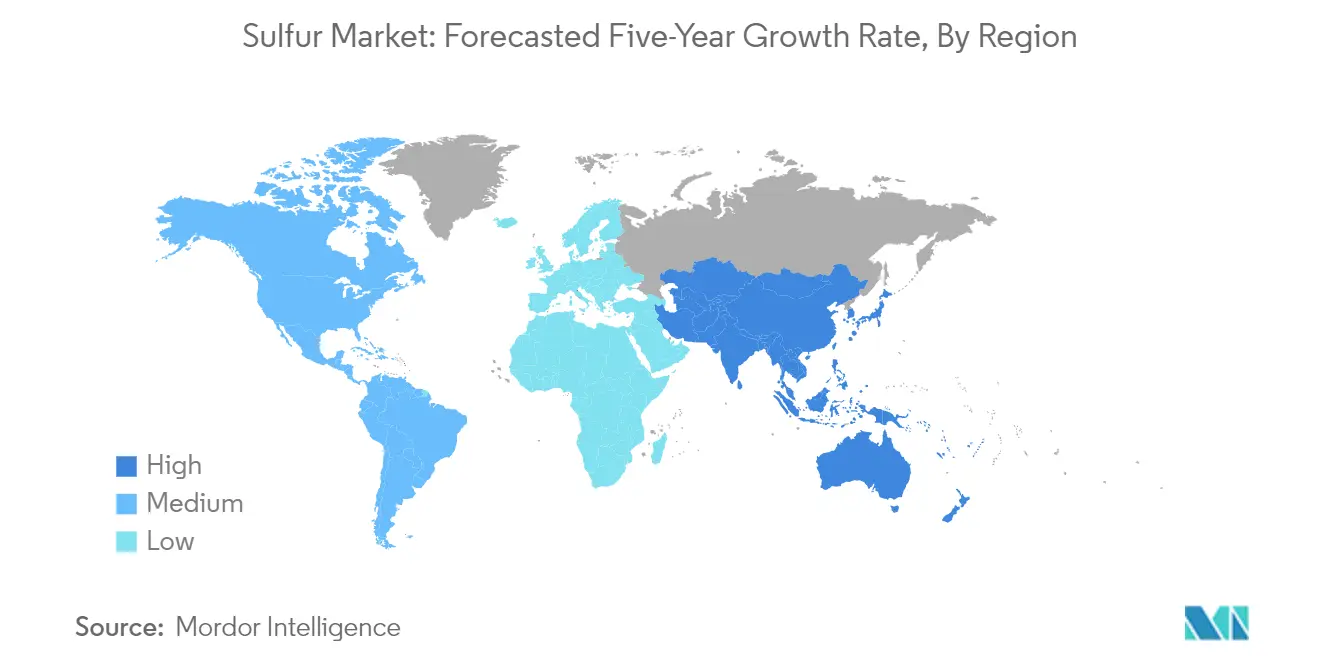
Sulfur Market in China
China maintains its position as the largest sulfur market in Asia-Pacific, commanding approximately 45% of the regional market share. The country's dominance is supported by its extensive chemical processing industry and substantial fertilizer manufacturing sector. The nation's robust steel industry and expanding rubber processing capabilities further reinforce its market leadership. China's chemical sector continues to grow with significant investments in new chemical plants and expansion projects, while its position as the world's largest steel producer ensures steady demand for sulfur in various industrial applications.
Sulfur Market Growth Trajectory in China
China is experiencing the fastest growth in the Asia-Pacific region, with a projected CAGR of approximately 7% during 2024-2029. This growth is primarily driven by the country's expanding chemical manufacturing base and increasing investments in new production facilities. The nation's commitment to developing eco-friendly steel manufacturing processes and the growing adoption of electric arc furnace technology are creating new opportunities for sulfur consumption. Additionally, China's tire manufacturing industry expansion and pharmaceutical sector development are contributing to the accelerated market growth.
Sulfur Market in North America
North America represents a significant sulfur market, characterized by advanced industrial infrastructure and substantial domestic production capabilities. The United States dominates the regional landscape with its extensive petroleum refining and chemical manufacturing sectors. Canada contributes significantly through its oil sands operations and natural gas processing facilities, while Mexico's growing industrial base and expanding chemical sector add to the regional market dynamics.
Sulfur Market in United States
The United States maintains its position as the largest sulfur market in North America, holding approximately 74% of the regional market share. The country's leadership is underpinned by its position as the world's second-largest sulfur producer and its extensive network of petroleum refineries. The nation's robust chemical industry, significant fertilizer manufacturing sector, and substantial steel production capabilities continue to drive steady demand for sulfur across various applications.
Sulfur Market Growth Trajectory in United States
The United States is experiencing the strongest growth in North America, with a projected CAGR of approximately 5% during 2024-2029. This growth is supported by increasing investments in domestic fertilizer production capacity and expanding chemical manufacturing facilities. The country's focus on environmental regulations and sustainable manufacturing practices is driving demand for sulfur in various industrial applications. Additionally, the robust pharmaceutical sector and growing tire manufacturing industry contribute to the market's upward trajectory.
Sulfur Market in Europe
Europe maintains a significant presence in the global sulfur market, with a diverse industrial landscape across multiple countries. Germany leads the regional market with its advanced chemical and automotive industries, while Russia's extensive oil and gas operations contribute substantially to regional supply. France, the United Kingdom, and Italy each play important roles with their respective chemical processing and industrial manufacturing sectors.
Sulfur Market in Germany
Germany stands as the largest sulfur market in Europe, driven by its position as a leading chemical manufacturer and significant fertilizer producer. The country's extensive automotive industry and rubber processing sector contribute significantly to sulfur demand. Despite recent challenges in the chemical industry, Germany's market leadership is maintained through its strong industrial base and technological advancement in various manufacturing sectors.
Sulfur Market Growth Trajectory in Russia
Russia demonstrates the highest growth potential in the European region, supported by its extensive oil and gas operations and expanding chemical industry. The country's significant investments in industrial infrastructure and growing fertilizer production capabilities are driving market growth. Additionally, Russia's metal manufacturing sector and increasing focus on domestic chemical production contribute to its market expansion.
Sulfur Market in South America
The South American sulfur market is characterized by growing industrial activities and expanding agricultural sectors across the region. Brazil emerges as the largest market, supported by its extensive fertilizer industry and chemical manufacturing sector, while also showing the fastest growth potential. Argentina follows as a significant market with its developing chemical industry and agricultural sector. The region's focus on agricultural development and increasing industrial activities continues to drive sulfur demand across various applications.
Sulfur Market in Middle East and Africa
The Middle East and Africa region presents a dynamic sulfur market, with significant production capabilities and growing industrial applications. South Africa represents the largest market in the region, driven by its diverse industrial base and expanding chemical sector, while Saudi Arabia shows the fastest growth potential supported by its extensive oil and gas operations and developing chemical industry. The region's ongoing industrialization and increasing focus on domestic manufacturing capabilities continue to shape market dynamics.
Sulfur Industry Overview
Top Companies in Sulfur Market
The global sulfur market features prominent players like Gazprom International, ADNOC, Shell, Saudi Arabian Oil Co., and China Petrochemical Corporation (Sinopec) leading the industry through various strategic initiatives. Companies are focusing on expanding their production capacities through new plant establishments and technological upgrades, particularly in sulfur recovery and granulation facilities. Strategic partnerships and long-term supply agreements have become increasingly common, as demonstrated by recent collaborations between major players and regional distributors. Operational excellence is being prioritized through investments in advanced processing technologies and automation, while sustainability initiatives are gaining prominence through improved environmental management systems. Product innovation efforts are primarily directed towards developing higher-grade sulfur products for specialized applications, while geographical expansion strategies are targeting emerging markets with growing industrial bases.
Fragmented Market with Regional Supply Dynamics
The global sulfur industry exhibits a fragmented structure with the top five players accounting for approximately one-fifth of the market share, while numerous regional and local players serve specific geographical markets. The market is characterized by a mix of integrated energy conglomerates, who produce sulfur as a byproduct of their oil and gas operations, and specialized chemical companies focusing on sulfur processing and distribution. The presence of state-owned enterprises, particularly in the Middle East and Asia-Pacific regions, adds another dimension to the competitive landscape, as these companies often have preferential access to raw materials and government support. The industry has witnessed several strategic acquisitions and joint ventures, particularly in emerging markets, as companies seek to strengthen their regional presence and secure reliable supply chains.
The market demonstrates varying levels of consolidation across different regions, with more concentrated structures in developed markets and fragmented competition in emerging economies. Major players are increasingly pursuing vertical integration strategies, establishing control over the entire value chain from production to distribution. The competitive dynamics are further influenced by the geographic proximity to end-user industries, particularly fertilizer manufacturers and chemical processing units, which often drives localized competition and pricing strategies. Companies with strong logistics networks and storage capabilities have a distinct advantage in managing supply fluctuations and meeting customer demands efficiently.
Innovation and Sustainability Drive Future Growth
Success in the sulfur industry increasingly depends on companies' ability to adapt to evolving environmental regulations while maintaining operational efficiency. Market leaders are investing in cleaner production technologies and sustainable practices to comply with stricter environmental standards and meet growing customer demands for environmentally responsible products. The development of value-added sulfur products and applications in new industries presents opportunities for differentiation and market expansion. Companies that can effectively integrate digital technologies for process optimization and supply chain management while maintaining cost competitiveness will likely gain advantages in the market.
For new entrants and smaller players, success lies in identifying and serving niche market segments or specific geographic regions where larger players may have limited presence. Building strong relationships with end-users through reliable supply and technical support services is crucial for maintaining market position. The industry's future will be shaped by factors such as the ability to secure long-term supply contracts, develop efficient logistics networks, and adapt to changing end-user requirements. Companies must also consider the impact of energy transition trends on traditional sulfur sources and prepare for potential shifts in supply patterns. The development of strategic partnerships and investment in research and development capabilities will be critical for maintaining competitiveness in this evolving market landscape.
Sulfur Market Leaders
-
China Petroleum & Chemical Corporation
-
Abu Dhabi National Oil Company
-
Gazprom International Limited
-
ADNOC Group
-
Shell Plc
- *Disclaimer: Major Players sorted in no particular order
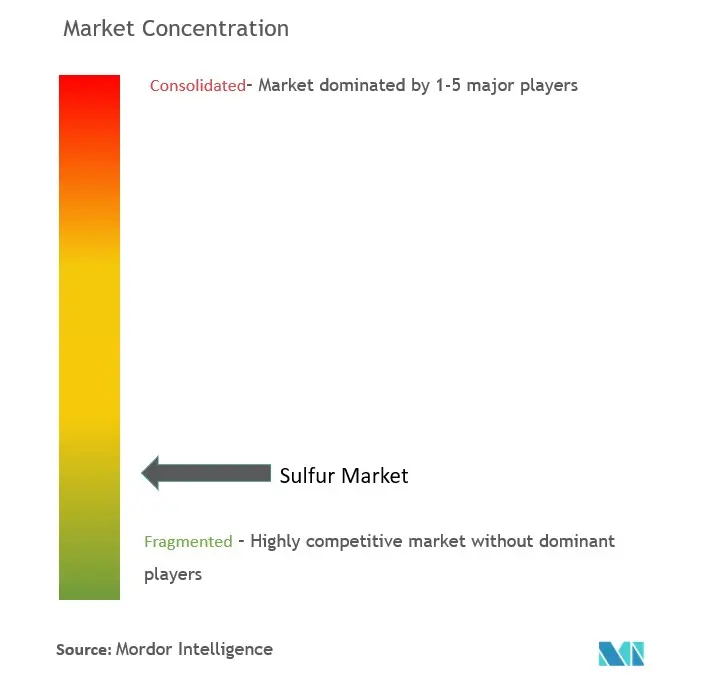
Sulfur Market News
- In January 2023, Technip Energies was awarded a contract for the modernization of sulfur recovery equipment at Aramco's Riyadh Refinery as part of its long-term agreement with Aramco. In order to comply with stricter emission regulations for sulfur dioxide and to improve the performance of the existing three sulfur recovery units SRU, this contract covers the installation of three new tail gas treatment units TGT, with a recovery efficiency of more than 99.9%.
- In April 2023. Valero Energy Corp (VLO.N) initiated the manufacturing on a new coker at its 335,000-barrel-per-day (bpd) Port Arthur, Texas, refinery. The restart of production of the new 55,000bpd coker follows the completion of the overhaul of the 115,000-bpd AVU-147 crude distillation unit. The unit uses hydrogen to remove sulfur from gas oil, gasoline and diesel feedstocks.
Sulfur Industry Segmentation
Sulfur is a multivalent non-metal, abundant, tasteless, and odorless. In its native form, sulfur is a yellow crystalline solid. In nature, it occurs as a pure element or as sulfide and sulfate minerals.
The sulfur market is segmented by form, technology (finishing process), end-user industry, and geography. By form, the market is segmented into solid and liquid. By technology, the market is segmented into granules, pastilles, and prilling. By end-user industry, the market is segmented into fertilizer, chemical processing, metal manufacturing, rubber processing, and other end-user industries. The report also covers the market size and forecasts for the sulfur market in 16 countries across major regions. For each segment, the market sizing and forecasts have been done on the basis of volume (million metric tons).
| Form | Solid | ||
| Liquid | |||
| Technology (Finishing Process) | Granules | ||
| Pastilles | |||
| Prilling | |||
| End-User Industry | Fertilizer | ||
| Chemical Processing | |||
| Metal Manufacturing | |||
| Rubber Processing | |||
| Other End-user Industries | |||
| Geography | Asia-Pacific | China | |
| India | |||
| Japan | |||
| South Korea | |||
| ASEAN Countries | |||
| Rest of Asia-Pacific | |||
| North America | United States | ||
| Canada | |||
| Mexico | |||
| Europe | Germany | ||
| United Kingdom | |||
| Italy | |||
| France | |||
| Russia | |||
| Rest of Europe | |||
| South America | Brazil | ||
| Argentina | |||
| Rest of South America | |||
| Middle-East and Africa | Saudi Arabia | ||
| South Africa | |||
| Rest of Middle-East and Africa | |||
| Solid |
| Liquid |
| Granules |
| Pastilles |
| Prilling |
| Fertilizer |
| Chemical Processing |
| Metal Manufacturing |
| Rubber Processing |
| Other End-user Industries |
| Asia-Pacific | China |
| India | |
| Japan | |
| South Korea | |
| ASEAN Countries | |
| Rest of Asia-Pacific | |
| North America | United States |
| Canada | |
| Mexico | |
| Europe | Germany |
| United Kingdom | |
| Italy | |
| France | |
| Russia | |
| Rest of Europe | |
| South America | Brazil |
| Argentina | |
| Rest of South America | |
| Middle-East and Africa | Saudi Arabia |
| South Africa | |
| Rest of Middle-East and Africa |
Sulfur Market Research FAQs
What is the current Sulfur Market size?
The Sulfur Market is projected to register a CAGR of 4.73% during the forecast period (2025-2030)
Who are the key players in Sulfur Market?
China Petroleum & Chemical Corporation, Abu Dhabi National Oil Company, Gazprom International Limited, ADNOC Group and Shell Plc are the major companies operating in the Sulfur Market.
Which is the fastest growing region in Sulfur Market?
Asia Pacific is estimated to grow at the highest CAGR over the forecast period (2025-2030).
Which region has the biggest share in Sulfur Market?
In 2025, the Asia Pacific accounts for the largest market share in Sulfur Market.
What years does this Sulfur Market cover?
The report covers the Sulfur Market historical market size for years: 2019, 2020, 2021, 2022, 2023 and 2024. The report also forecasts the Sulfur Market size for years: 2025, 2026, 2027, 2028, 2029 and 2030.

